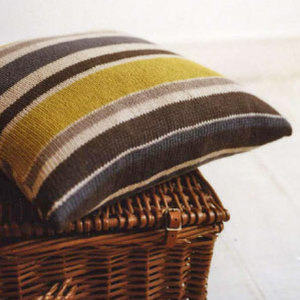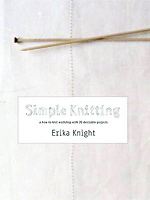Knit an Erika Knight striped cushion: free pattern
Simple and stylish, knit this design by Erika Knight

A simple square cushion cover worked in the perennially popular stocking stitch using a palette of complementary earthy shades, plus a shot of lime, in this five-colour stripe. The back button fastening lends added decorative detail - and it is the perfect place to start practising how to work a buttonhole.
Size
Finished size of cushion once made up: approximately 40cm square
Actual size of knitted piece: 40cm wide by 80cm high
Materials
A 1 x 50g ball in dark grey
B 2 x 50g balls in off white
C 1 x 50g ball in dark brown
D 1 x 50g ball in taupe
E 1 x 50g ball in lime green
Pair each of 3.25mm and 4mm knitting needles
Large blunt-ended sewing needle
5 buttons, 2cm in diameter
40cm square feather cushion pad
Tension
22 stitches and 30 rows to 10cm square over stocking stitch using 4mm needles
To make the cushion
Using 3.25mm needles and yarn C, cast on 88 sts and work 6 rows in k1, p1 rib as folls:
Row 1 (RS) * K1, p1, rep from * to end.
Row 2 * K1, p1, rep from * to end.
Change to yarn B and work 7 rows in k1, p1 rib as set.
Change to 4mm needles and yarn A, beg with a knit row cont in stocking stitch - knit one row and purl one row alternately - using the stripe sequence given until *.
Note, you have already worked the first 2 stripes in the rib band and are starting the third stripe.
Change to 3.25mm needles and yarn C, work 5 rows in k1, p1 rib as set, ending with RS facing for next row.
Buttonhole row 1 Rib 6 sts, cast off next 3 sts, [rib until 15 sts on RH needle, cast off next 3 sts] rep four times more, rib to end.
Buttonhole row 2 Change to yarn B, work across row in k1, p1 rib as set but cast on 3 sts over those cast off on previous row.
With yarn B, work 5 more rows in k1, p1 rib.
Cast off in rib.
Weave in any loose yarn ends.
Lay the work out flat and gently steam the finished piece on the reverse. Fold along marked lines making sure buttonhole band is on top of button band.
Join side seams, sewing through all layers.
Sew buttons on button band to match buttonholes.
Insert cushion pad.
Stripe sequence
C 6 rows
B 7 rows
A 13 rows
B 6 rows
D 6 rows
B 3 rows
E 6 rows
B 6 rows
A 6 rows
B 3 rows
C 9 rows
Place marker at each end of last row for fold line
A 4 rows
B 1 row
C 9 rows
B 4 rows
D 4 rows
B 1 row
E 16 rows
B 3 rows
C 6 rows
B 7 rows
A 13 rows
B 6 rows
D 6 rows
B 3 rows
E 6 rows
B 6 rows
A 6 rows
B 3 rows
C 9 rows
Place marker at each end of last row for fold line
A 4 rows
B 1 row
C 9 rows
B 4 rows
D 4 rows
B 1 row
E 16 rows
B 3 rows
*C 6 rows
B 7 rows
How to make a buttonhole
There are several different types of buttonholes within knitting - horizontal, vertical, eyelet, yarn over to name a few. I have used just one method for all the projects within this book, the horizontal buttonhole made over two rows as it is a good, all-purpose method that suits both garments and homewares alike.
Buttonholes need to be spaced evenly so that the band will not gap when it is buttoned. Some patterns will say something like ‘work six buttonholes evenly spaced', but it can be tricky to work it all out correctly if you are having to guess how many rows between each buttonhole. In this cushion cover pattern I have taken all the guesswork out of spacing the buttonholes by putting them horizontally along two rows.
Match your buttons to the size of the buttonhole; as knitted fabric stretches, the button should be only just able to slip through the hole. If you are in any doubt, knit a sample swatch with a buttonhole to determine whether it is the correct size. A good rule of thumb is that a buttonhole should be two stitches smaller than the width of the button. A horizontal buttonhole is made by casting off stitches on one row that are then offset by casting on the same amount of stitches on the following row. Unless otherwise specified in the pattern, the first cast off row of the buttonhole is worked on the right side of the piece. This is a very versatile technique as either fewer or more stitches can be cast off to vary the size of the buttonhole.
On the first row, work to the position of the buttonhole. Work two stitches and then lift the first stitch over the second one to cast off one stitch. Continue casting off the required number of stitches; for this cushion cover, it is three stitches for each buttonhole repeated at regular intervals along the row. Work to the end of the row. On the return row, work to the cast off stitches. Turn the work and put the tip of the right-hand needle between the first two stitches on the left-hand needle. Using the cable cast-on technique, cast on the same number of stitches cast off on the previous row. Turn the work back and complete the row.

This pattern is taken from 'Simple Knitting' by Erika Knight (Quadrille, £16.99)
You might also like...
See all of our cushions to knit and crochet: free patterns
See all of our free knitting patterns for your home
See all of our designer knitting patterns here










